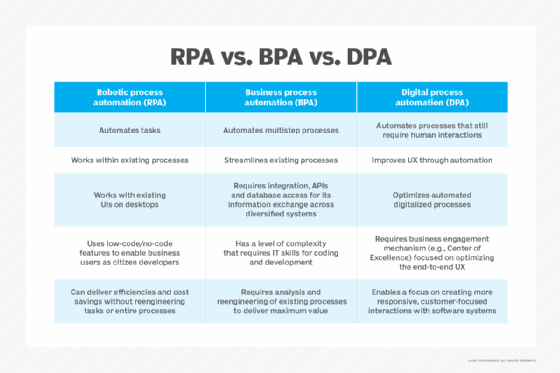
digital process automation
What is digital process automation (DPA)?
Digital process automation (DPA) uses low-code development tools to automate processes that can span multiple applications. The approach focuses on automating, or partially automating, tasks involved in a variety of business practices that typically require some form of human interaction.
Because DPA can span many applications, it is used in enterprise digital transformation initiatives to streamline business processes, eliminate inefficiencies, reduce costs and optimize customer journeys. Business functions where DPA software is used to automate and optimize workflows include sales, marketing, management, information technology and production.
DPA is often described as the evolution of business process management (BPM). As such, organizations that have experience with BPM should be able to easily implement DPA.
The term DPA was coined by Forrester Research in 2017 to reflect the observation that businesses were transitioning away from traditional business process management software (BPMS) to speed up their digital transformation journeys. Traditional BPMS and business process automation (BPA) tools were sometimes perceived as cumbersome and complex, requiring expert coders and less than optimal for integrating disparate applications.
This article is part of
Ultimate guide to RPA (robotic process automation)
Forrester has since differentiated the digital process automation field into DPA Deep and DPA Wide. DPA Deep tools represent the evolution of traditional BPMS tools into nimbler, low-code development tools that are easier to provision in the cloud and integrate with other cloud and enterprise applications. DPA Wide tools represent much lighter tools that are less expensive to acquire and implement, better suited for automating simple processes and accessible to a wider audience of business users.
Common digital process automation goals include maintaining transparency across processes, featuring some form of notification and reminder abilities, as well as automating potential customer tasks.

Benefits of digital process automation
The benefits of digital process automation include time savings, cost savings, efficiency gains and improved customer satisfaction and experience. DPA lets organizations complete tasks faster and automate repetitive tasks. As a result, employees are free to focus on more important aspects of the business.
In addition, employees with continually updated workflow information don't have to spend as much time making sure their workflows are up to date or tracking down lost documents. Organizing and digitizing processes also allow an organization to quickly shift goals if needed.
When workflow elements are automated, employees have more time to focus on optimization in other areas. For example, they can improve their products and services, and enhance the customer experience.
Digital process automation examples
DPA can be used to automate aspects of many common business processes:
- Customer onboarding. DPA can connect the dots between various tasks that need to be reliably executed when onboarding customers. This can streamline the customer journey and streamline the customer experience. DPA helps execute tasks like automatically kicking off background checks, entering data across multiple applications, generating login credentials, setting up accounts and sending off welcome emails.
- Procurement. DPA can help automate many background processes such as copying data between enterprise resource planning and ordering systems, entering data into tracking systems and automatically entering invoicing data into finance systems after an order has been placed.
- Order fulfillment. DPA can help automate various back-end processes associated with ordering and fulfilling new products, resulting in a more customer-centric approach to shipping. Automations could include estimating fulfillment and delivery times, calculating local taxes, generating a shipping manifest, tracking the status of an order and confirming receipt of a package by the customer.
Digital process automation vs. business process automation
Digital process automation, business process modeling, BPM and BPMS are types of BPA tools used for workflow automation. However, many experts have observed that the industry is gravitating away from using the terms BPM and BPA to characterize a specific approach to enterprise automation. Nonetheless, BPA and DPA have subtle differences in terms of focus.
BPA encompasses a wider range of business processes and practices that don't necessarily have to be digital. It can automate routine, repetitive tasks that have traditionally required manual human activity.
On the other hand, DPA is focused on automating machine-centric processes. These include complicated workflows and tasks with many sequential steps that are more efficiently handled with advanced automation technologies.
Digital process automation vs. robotic process automation
Digital process automation can also be easily confused with another term: robotic process automation (RPA).
RPA allows companies to create software robots or bots that mimic human interaction with software to automate high-volume, repeatable tasks. RPA can be used to automate queries and calculations, as well as maintain records and transactions.
Because RPA automates applications by emulating how humans use software, it's relatively easy to deploy on top of existing applications. It is also intuitive for business users to implement because it works in the way they're used to interacting with apps.
In contrast, DPA requires implementing and integrating a low-code platform, which can take some time to get started. Also, DPA applications must be coded. However, the benefit of DPA is that these applications tend to be more scalable than RPA because they integrate into other applications using application programming interfaces rather than the user interface.
Both RPA and DPA can be combined with artificial intelligence (AI) and machine learning (ML) tools to implement intelligent process automation (IPA) capabilities.
The role of AI in digital process automation
AI is a valuable way to enhance DPA. AI and ML algorithms make it possible to process large amounts of data and glean important insights and predictions. When integrated with DPA systems, those algorithms provide important insights and analyses to guide the systems' automation decisions and improve process efficiency.
For instance, an IPA system might use DPA to cull data and feedback from different sources about a business's products and then use AI capabilities for analysis. This system would produce product recommendations and predict consumers' future purchasing behaviors. As AI evolves, IPA platforms and capabilities will become more common.
How to successfully implement DPA in 4 steps
The four basic steps of DPA implementation are the following:
- Identify automation candidates. Managers and business users should start by identifying a process they want to automate. This step could take advantage of process mining tools to automatically identify and prioritize automation opportunities.
- Coordinate with IT. Management and finance teams should work with IT or their automation center of excellence teams to evaluate whether the automation should be implemented using DPA, RPA or a dedicated cloud service.
- Ensure governance. Security and privacy teams should work with IT and management teams to vet DPA tools and identify any risks with automations.
- Start small and scale. Teams should start with simple processes that deliver short-term returns on investment to build confidence in the process and excitement about the potential. Once these efforts start to pan out, an organization can begin planning a hyperautomation strategy to help scale the process of implementing digital process automation.
Digital process automation tools
One way to think about DPA tools is to use Forrester's schema of DPA Deep and DPA Wide.
DPA Deep tools tend to be better suited for building long-running processes. These often build on traditional business process modeling practices and case management capabilities and are ideal for industries such as banking, insurance and healthcare that have strong process requirements. Representative vendors include traditional BPMS and case management vendors such as Appian, Bizagi, Bonitasoft, Genpact, IBM, Kofax, OpenText and Pega.
DPA Wide tools are better suited for rapid development of automated process platforms. These tools have strong process modeling and orchestration capabilities, low-code tools for business users and some IT governance capabilities. Leading DPA Wide vendors include AgilePoint, Axon Ivy, Creatio, JobRouter, Newgen, Nintex and Ultimus.
Digital process automation software might combine low-code/no-code workflows with RPA, AI, ML and business rules engine capabilities for building out more sophisticated workflows. They can include features such as automation capabilities, notifications and application development tools.
Digital transformation encompasses all the different approaches a business can take to implement and combine technologies such as DPA, RPA, AI and ML. Learn about the benefits of a digital transformation effort.





